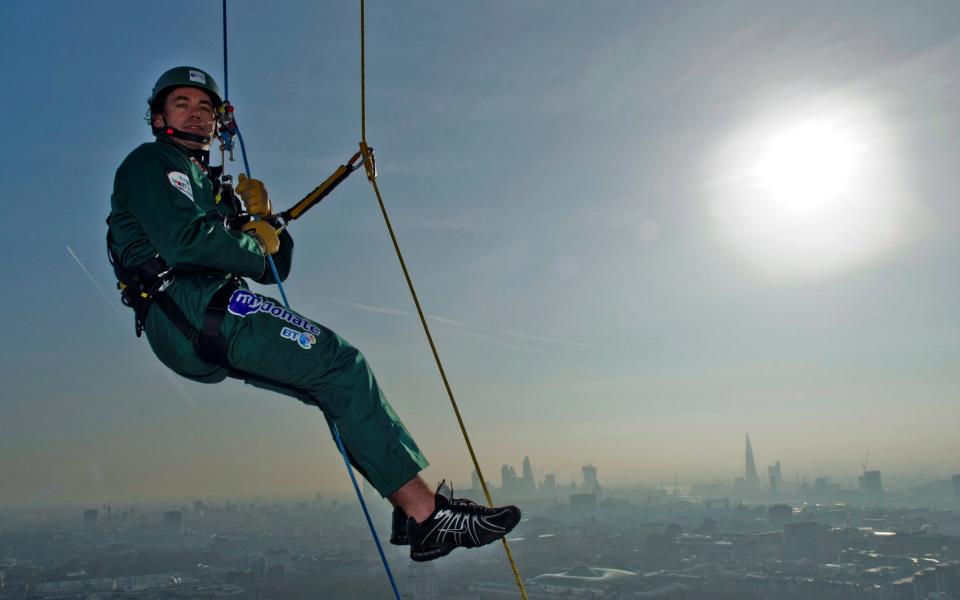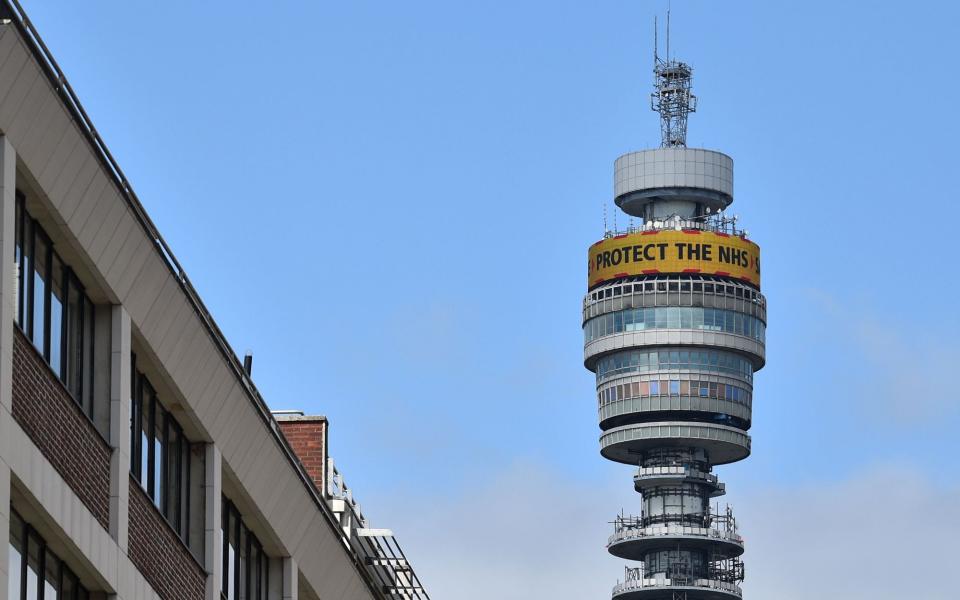For Gavin Patterson, abseiling down the BT Tower remains a memorable highlight of his tenure as CEO of the telecoms giant.
The stunt, performed with TV adventurer Bear Grylls, was just one of many charity events hosted at the London landmark over the years.
But the BT Tower will now start a new life as a hotel after BT signed a £275 million deal to sell the building to a US-based hotel chain.


Initially known as the Post Office Tower, the skyscraper was born out of necessity and began life as a crucial hub for transmitting TV and telephone signals across the United Kingdom.
But as these services shifted to more modern networks, the monument’s purpose faded from functional to symbolic – and became an increasing headache for BT bosses.
In the modern world, the building’s technological value is limited according to former BT chairman Sir Mike Rake, who describes it as an “iconic white elephant”.
The Grade II listed tower in Fitzrovia was completed in 1964 and opened for operations by Prime Minister Harold Wilson the following year, before being admitted to the public in 1966 by Postmaster General Tony Benn.
For Benn, the project was the sign of a new Britain rising from the ashes of war – a project as representative of its time as the Elizabeth Tower that housed Big Ben.
“Big Ben represents the fastidious grandeur of the Gothic Revival that epitomized Victorian imperial prosperity, built on the foundations of the first Industrial Revolution,” he said.
“The Post Office Tower, sleek, practical and futuristic, symbolizes the technical and architectural skills of this new era.”
It towers 189 meters above London and was Britain’s tallest building until 1980, when it was taken over by the NatWest Tower in the City of London.
The tower was open to the public until 1971 and had a restaurant on the revolving top floor, operated by holiday resort owner Butlin’s.
Public access ended that year when a suspected IRA bomb exploded on the 31st floor. No one was injured in the attack, but it took two years to repair the damage. The restaurant closed nine years later, in 1980, when its lease expired.
Since 1984, the suite at the top of the tower has been used by BT as a corporate hospitality space and for charity events.
In 2009, the tower’s 360-degree LED screen, also called the “information tape”, was launched. It was used to display the countdown to the 2012 London Olympics, as well as to convey messages during national events such as the pandemic.
In recent years the building, which until 1993 was technically under the Official Secrets Act, has only opened its doors to the public for special events.
In 2015, the revolving restaurant reopened for one night, while in 2018 four guests were given a once-in-a-lifetime opportunity to glamp on the skyscraper’s 34th floor.
Patterson, then CEO of BT, praised the building as a “unique feat of engineering” to mark its half-centenary, adding: “It has been a working icon of technological innovation for 50 years.”
However, behind the publicity stunts was a less glamorous story.
Apart from a state-of-the-art control room on the lower floors, much of the building has been vacant for years. The microwave antennas, an important part of the structure’s design, were removed more than a decade ago.
As a result, successive BT bosses were at a loss as to what to do with the monument.


The bosses tried to reopen the restaurant but this was always refused due to safety concerns.
The company has also approached previous acquisition interests from Middle Eastern investors, but disagreements over valuation and concerns about the difficulty of removing remaining equipment have hampered any potential deal.
Patterson describes the process as a “huge undertaking.”
“I’m sure we’ve all looked at it with every CEO, but it always fell into the ‘too hard to do’ pile,” he adds.
“I think it’s a good move, because ultimately something has to be done with the building. It’s a huge honor for getting the job done.”
As part of the deal, hotel company MCR will make phased payments as remaining equipment is removed from the building.
“The proposal to convert the BT Tower into a hotel shows that new uses can be found for even the most unlikely and iconic listed buildings,” said Henrietta Billings, director of SAVE Britain’s Heritage, which is campaigning to find new uses for historic buildings.
“If done right, this could be one of London’s most exciting new destinations. We await the new plans with interest.”
The decision to sell the tower comes in the early weeks of Allison Kirkby’s tenure as CEO, although the deal was likely pushed through by chief financial officer Simon Lowth.
It comes amid wider cost cuts at BT, which has announced plans to cut 55,000 jobs by the end of the decade in a bid to cut £3 billion from the business.
Although £275 million is a relatively modest sum for a company the size of BT, the savings on operating costs are likely to be significant.
In 2019, BT sold its former BT Center headquarters for £210 million and moved to a new building in Aldgate. It has also drawn up plans to reduce the number of offices on its estate from more than 300 to around 30.
Bosses are likely to scrutinize the group’s property portfolio across the country, not least former telephone exchanges, for potential sales.
For the BT Tower, the sale promises a new life under the control of MCR Hotels, the third-largest hotel owner in the US, which operates the TWA at JFK Airport and the Sheraton in Times Square, among others.
MCR is led by Tyler Morse, an experienced hotel manager who started his career in the hospitality industry as a baggage handler, ski instructor, busboy and valet.
The company has provided little information about its plans for the project, which in addition to the tower also includes a “podium” of buildings spanning an entire block.
However, MCR has said it will work with Heatherwick Studio, the London-based architectural firm behind projects such as Coal Drops Yard in King’s Cross and the Vessel structure in New York.
Thomas Heatherwick, the studio’s founder, said it was an “extraordinary building and a great opportunity to bring it back to life”.
Naomi Nettleton, real estate partner at law firm Charles Russell Speechlys, says there is a “growing trend to repurpose London’s iconic buildings as hotels”, pointing to the recent opening of Raffles in the Old War Office in Whitehall.
She added: “The BT Tower is an iconic London building in a prime location, so the proposal to turn it into a hotel is not surprising. Unique architectural buildings such as hotels provide robust real estate foundations – whether that is prestige, distinctive design or sense of heritage.”
London is currently experiencing a huge growth in luxury hotels, where rooms cost £1,000 per night.
The five-star Peninsula Hotel recently opened near Hyde Park, while there is a wave of luxury openings in the pipeline from brands including Mandarin Oriental and Claridge’s.
Yet the project is likely to come under scrutiny from heritage and environmental campaigners, against the backdrop of fierce debate over developments in the capital.
London Mayor Sadiq Khan recently blocked the MSG Sphere, a huge Las Vegas-style concert venue planned for east London, while Marks & Spencer has launched a High Court battle against Michael Gove’s decision to block the redevelopment of its flagship Marble Arch store.
Catherine Croft, director of campaign group Twentieth Century Society, describes the BT Tower as a “fantastic building, which absolutely exemplifies the technological innovation and ambition of the 1960s”.
She adds that the conversion to a hotel will be “challenging,” but points to MCR’s previous experience creating massive concrete shells at the TWA at JFK.
A spokesperson for MCR said: “MCR is fully aware that the tower is a Grade II listed structure and will have time to consider the appropriate design approach and engage with local communities, Camden Council, the GLA, heritage organizations and other stakeholders.”
Ultimately, the complex removal of equipment and lengthy planning processes mean it could be years before the BT Tower begins its new life as a hotel.
But Londoners will be hoping they can once again dine in a revolving restaurant overlooking the city.
“It’s a stunning acquisition,” says Croft. “Every city should have one.”
Even if abseiling is out of the picture, the public may soon get the chance to experience those sweeping views of London again.